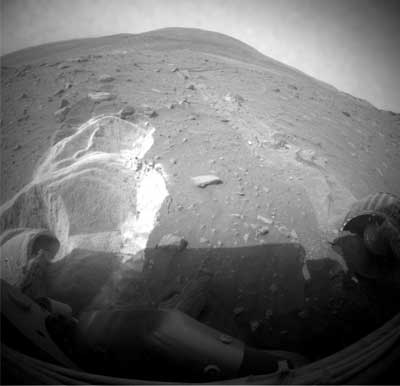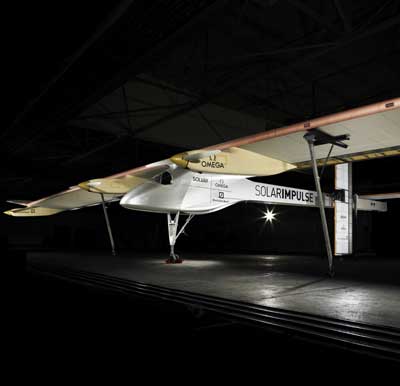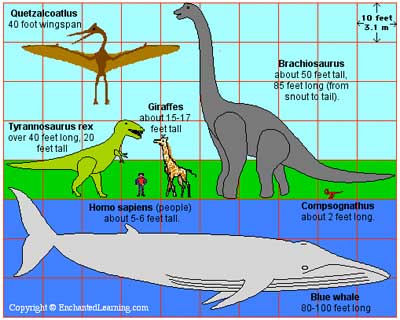 Welcome to Science Friday! This week, explore mars with the sand trapped Spirit rover, see Cpt. Piccard fly a solar plane, own your very own robot scientist, and send a message to whales in space. All this an more plus our gadget of the week: the collapsible lampshade that’s made with lasers!
Welcome to Science Friday! This week, explore mars with the sand trapped Spirit rover, see Cpt. Piccard fly a solar plane, own your very own robot scientist, and send a message to whales in space. All this an more plus our gadget of the week: the collapsible lampshade that’s made with lasers!
Sand Trapped Spirit Rover Makes Big Discovery
As you may know, the MER Rover Spirit got stuck recently while roving around a small crater on the dusty red planet. Well it turns out, just as previous follies have led to cool discoveries before, that the act of Spirit trying to free herself has turned up something interesting in the Martian soil. “Spirit had to get stuck to make its next discovery,” says Arvidson. As the rover tried to break free, its wheels began to churn up the soil, uncovering sulfates underneath. “Sulfates are minerals just beneath the surface that shout to us that they were formed in steam vents, since steam has sulfur in it. Steam is associated with hydrothermal activity – evidence of water-charged explosive volcanism. Such areas could have once supported life.” Great news from the sand trapped rover who is still trying to break free.

Spirits view of her own predicament. Notice the buried wheel in the lower left-hand side of the image.
Captain Piccard Flies a Solar-Powered Plane
A Swiss adventurer named Bertrand Piccard has successfully launched and landed an experimental solar-powered plane. According to Piccard, the low altitude journey proved the prototype Solar Impulse was capable of safely flying – even though it traveled only 350 meters. Although Piccard conceded that the maiden voyage of the Solar Impulse may appear to be little more than a “flea hop,” he insisted that it represented a totally “new and uncharted” way of flying. “Never before – in the whole history of aviation – has an aircraft so big, so light and consuming so little energy actually flown." (via TG Daily)

See more cool pictures and video at the Solar Impulse website
Download Your Own Robot Scientist!
Ever wanted to have a robot to do your research for you? If you are a scientist, you have almost certainly had this dream. Now it’s a real option: Eureqa, a program that distills scientific laws from raw data, is freely available to researchers. The program was unveiled in April, when it used readouts of a double-pendulum to infer Newton’s second law of motion and the law of conservation of momentum. It could be an invaluable tool for revealing other, more complicated laws that have eluded humans. And scientists have been clamoring to get their hands on it. “In most of science, you try to keep everything constant except for one variable. You turn one knob at a time, and see how the system responds. That’s wonderful for linear systems,” said a Eureqa user. “But most biology is complex and non-linear. Emergent behaviors are very hard to understand unless you turn many knobs at a time, and we can’t figure out which knobs to turn. So we’re going to let Eureqa pick them.”
Check out the Eureqa video tutorial
Are Blue Whales Trying to Summon Their ET Brethren?
They may not be humpbacks, but Blue Whales have been singing a different tune lately, specifically their songs have changed to deeper tones, and scientists don’t know why. Mark McDonald, president of Whale Acoustics, a company that specializes in the sonic monitoring of cetaceans, noticed the change beginning 8 years ago. Their detectors are triggered by songs that match a particular waveform. Every year, McDonald had to set them lower. Scientists do not have any answers at this point, only lots of recordings and lots of questions. Of course, it seems obvious if you’re well versed in your history of the future. They are just communicating with the giant starship-destroying, rod-shaped probe floating in space near the whale home world! Any vulcan could tell you that!

Because EVERYTHING makes more sense when compared to dinosaurs!
Gadget of the Week: Collapsible Lamp Shade — Built With Lasers!
Thanks to smart geometry and engineering comes this collapsible lampshade, going from flat latticework to squared-off cube in an instant. Place it over a lighting fixture and you have a soothing, glowing shape that doesn’t seem to be from this world. Even more impressive than the final product is the way this unusual lampshade was created:
“The process works by sweeping a laser across a pan of powdered nylon; when the lasers hit the nylon, it fuses (“sinters”). The process repeats in layers, until the final product emerges. Thus, you can create interlocking shapes all at once–for example, a chain whose links are completely closed.”
Take a look at this video and you’ll see how it unfurls:
#FollowFriday
If you are on Twitter, you know there are plenty of amazing people out there tweeting away. And, many of them are scientists! Every Friday I’ll be bringing you a new list of great scientists and techies to follow on Twitter. This week…
- @CERN: CERN, the European Organization for Nuclear Research, is the biggest particle physics laboratory in the world.
- @Oatmeal: The oatmeal is full to the brim with comics, quizzes, and stories
- @ActuallyNPH: Niel Patrick Harris. I act some. Dig variety acts, Pixar, puppets, theme parks and great meals.
Science Quickies
Not enough science for you? Here’s a warp-speed look at some more science tid-bits that are worth a look.
- Microsoft, Google take maps in new directions
- Very old papers are both awesome and hilarious
TrekMovie’s Science Friday is an homage the the great NPR radio show Science Friday. Science Friday® is a registered service mark of ScienceFriday Inc.

I claim this space in the name of science!
First?
I’d like to do some whale acoustic research…
All I could think of after reading the whale story is “Sonar” from Down Periscope… urrrrreeeep. urk urk urk.
The whales are probably talking in lower registers trying to get past all the human-generated noise in the oceans. IF I remember my science right, the lower the frequency, the better it travels in sea water?
Isn’t “Piccard” spelled wrong? Shouldn’t it be one “C”?
So is that lampshade made of paper, or what? How would it not just catch on fire?
Piccard’s plane looks suspiciously Romulan in design! Are you sure that isn’t Bertrand Shinzon???
When the Rover accidentally uncovers the Schlitz can with pop top that the Martians dropped there at their last clam bake, then I’ll get excited.
That’s why you didn’t want to hang out with Newton when he had that ‘look in his eye.’
Apparently, instead of tracking a Blue whale, the cetacean specialists have zeroed in on the rare Barry White whale.
Great stuff, Kayla!
See, the difference in the spelling of “Piccard” may be all that separates our universe from that of Star Trek, but that fact nevertheless is sufficient to explain why progress in space has been so slow lately.
I mean, why not?
Also, here’s another bizarre thought: If Star Trek had never existed, it would have been necessary to create it.
;-)
#4: Correct. Submarines are often summoned to the surface for communications using an ELF (Extremely Low Frequency) burst, which can travel thousands of miles underwater, from my understanding.
that lampshade – Balok’s space bouy from Corbonite!!!
Two glasses of tranya sitting around that lamp for a great night in with some fine company, I reckon…hahahahahahahaha!!
3
LOL
4
u let me know when the ISS can hear it.
I wouldn’t be surprised if that lampshade showed up as a background prop in the next Trek production — it looks suitably future-y…
I like that collapsible lampshade/Gary Seven cube there.
#6. Imrahil “So is that lampshade made of paper, or what? How would it not just catch on fire?”
Nylon. As the article says.
Hey – I like that illustration with the dinosaurs and the blue whale. Anyone else think the human figure looks a little bit like Ian Malcolm? Seems tall enough…
Maybe there’s a “Jurassic Ocean” sequel in the works!
#4. Very true. Lower waves will travel farther than shorter waves. The only issue, which may not be an issue with Whales, is the amount of information you can send is less. Again, may not matter to whales.
I wonder if Bertrand Piccard is in anyway related to Jacques Piccard, French oceanographer and inspiration for Jean-Luc Picard?
I’m sure that Spirit will get out of that darn crater! Shes done it before!
…..or was that Opportunity?….
Oh. Yeah, dunno how I missed that. Guess I went straight to the video.
The Picard that fought at Trafalgar, the Picard that lived in the first Martian colony, the Picard …. that … built a solar powered plane ….
(cough)
Actually when you say it like that it sounds insignificant but it could easily be just as important. Hehe.
Your story was really ionrfamtive, thanks!